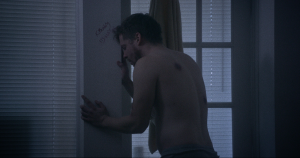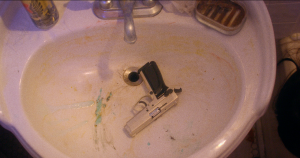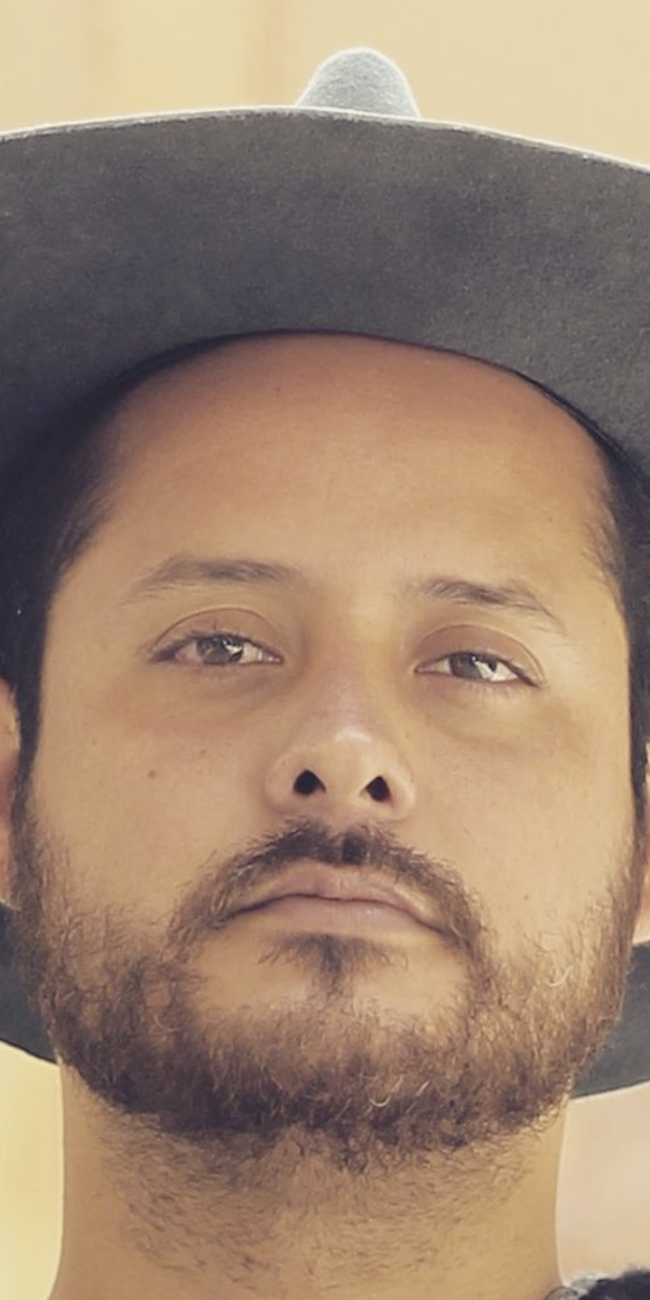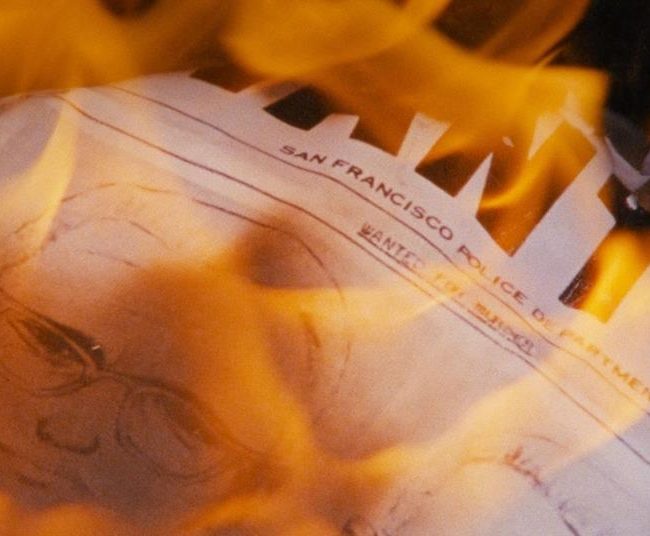A Conversation With Spencer Parsons (BITE RADIUS)

(Filmmaker Spencer Parsons is no stranger to horror films but he’s never made a film as horrific as his latest, the 30-minute short Bite Radius. Based on a real life murder the film centers on ne’er do-well party animals Peyton and Nicole who are forced to deal with a dead body. While indeed gruesome and extremely difficult to watch, the film is also handled smartly with some odd, subtle diversions from what viewers may expect. We talked to Parsons about the film, his mental state and his inspiration for the film ahead of the films bow at this years Sidewalk Film Festival).
HAMMER TO NAIL: Ok….first question: what the fuck is wrong with you?
Spencer Parsons: Hahaha. I like to think the same thing that’s wrong with lots of other people. As a filmmaker, I’m just maybe more willing to show everybody my dirty undies.
HTN: Ooof. But seriously, tell me a bit about the background for the film….it’s all based on a real killing, correct?
SP: Yeah, it’s based on a real incident that I heard about and became kind of obsessed with. The details of the crime as reported and the behavior of the individuals involved was really, really funny to me, and to a lot of the other sickos I hang around with, but I was also disturbed by my own laughter.
It’s fairly common, of course, to see sickening violence played as comedy in cinema or in fiction more generally, but the comedy of this real life news story made it more frightening in a way, and more transgressive.
And in terms of my interest in telling the story, part of it was about being upfront as regards my own laughter, my own prurience in relation to it. I didn’t feel that representing it in some kind of tasteful way that played down the grotesque elements and insinuations would be either true to the story itself or true to my heart, and would not implicate me (or the audience) enough. It wouldn’t have been honest to be more tasteful.
HTN: What was the…errr…inspiration for all the poop and smeary stuff all over his house?
SP: Oh, the poop. Well the smeary stuff all over the house was dried blood that he’d tracked around, and yeah, for the eagle-eyed, there’s also a puddle of vomit. But I guess it seemed right in this story that’s so much about bodies to go in for a variety of bodily fluids and effluvia. Not just blood.
I mean, I guess I do enjoy scat humor on one level, but on another, it brings us a bit closer to the characters in unexpected ways. Too close for sure, but also weirdly intimate, I think.
HTN: so in terms of you getting into the real life story and finding yourself laughing and kind of….entertained by it…..was the addition of Peyton just being a filthy person a way to add another layer of making it even harder to laugh at what’s going on? I mean it IS a sick/funny story and you tell it so well but it’s one thing to give Peyton and later, his lady friend Nicole ZERO remorse but another entirely to make the decision as a story teller to make them physically disgusting as well.
SP: Right. It’s interesting, because, you know, as the book says, everybody poops. I simply recognize that in the depiction of character, though certainly that emphasizes a basic aspect of life that is filthy and that we usually take pains to ignore. But it is leveling.
HTN: Sure, but Peyton also doesn’t wipe his ass very well, as you show so clearly!
SP: True. But perhaps he does find himself in an out of the ordinary situation that distracts him from that moment of hygiene.
The filth of his home had a lot to do with depicting a kind of laziness that I think a lot of young people indulge and that seemed to make sense as not just a character trait, but a kind of plot point. But yeah, obviously his place is extremely gross. It did seem realistic to us, and personally, I can identify with that kind of laziness. A little too closely.
HTN: Hmm…maybe. I think what I was wanting to get at–and as I mentioned before we started–relates to one of my professors at San Francisco State, Aaron Kerner. One of his big influences is Julia Kristeva who, among other heady subjects, really dives into this theory of “abjection.” To kind of (badly) rephrase it…..as humans we get repulsed by the “unsanitary” be it bodily function or just gore because it reminds us what those “disgusting” things are inside of all of us. I know you teach film…is her work something you’re aware of or into?
SP: Oh, yeah, that notion of abjection is definitely an aspect of storytelling that I’m aware of and that attracts me. Fiction cinema can a way of dealing with this aspect of human experience in a way that is safe—you know, even if it makes us throw up, it doesn’t make us sick, if you follow. My particular point of reference in that field is Steven Shaviro, a really terrific writer on Cronenberg and Romero, who are among my very favorite filmmakers. And obviously, their stuff is pretty seriously into the abjection. I’m also a big, big fan of Georges Bataille, and his work really influenced this film, especially in the way the violence and filth are sexualized.
In terms of Nicole’s particular filthiness, Sophie Traub, who plays her, and my costumer and I did a bit of field research into a certain kind of post-collegiate party girl. And weirdly, even having her wear daisy dukes in winter, the costume isn’t much an exaggeration. But then her desire to commune with Peyton’s filthiness as perhaps a way of gaining greater intimacy with this guy she loves is gross, but also, at least to me, a little poignant.
HTN: Yeah, the scene where he goes out to get the tools to take care of the body and she’s smoking and waiting for him to return and when he does, she gets into this kind of sultry pose was sweet but also sad. I thought your use of that area was so well thought out but not over the top, just enough little moments of real-life grossness that added depth to the characters.
SP: I did want to keep it all rooted in reality, even if the film isn’t exactly realism. I mean obviously, I knew that this story would be grotesque, but I wanted all of that to be grounded in milieu and character.
HTN: So to change the subject to a more nuts and bolts area…it would have been easy to shoot this film kind of down and dirty, use a lot of handheld but your decision to have everything on tripods, steady cams, tracks etc. really gives the film a sort of eerily majestic feel. Can you talk about that choice and what you wanted it to add to the film?
SP: Well, the handheld approach certainly would be the more obvious, and I do like handheld quite a bit. But for this story I wanted to create a bit of irony and contrast with the camera work. We’re in this world that’s really filthy, but the camera needed to float and glide a bit, in a way that’s dreamlike–nightmarish perhaps, but also a little romantic. I’ll add that I work with a great cinematographer, Drew Daniels (Krisha), who made this kind of camera work even more improvisational and responsive to the actors than handheld has been on some of my other films.
And we went for that because I wanted to connect the visuals to the characters’ experience more than to the audience’s experience or to my judgments of them. Just take seriously that they’ve woken up into a kind of dream—it’s a nightmare for one and sort of a wet dream to the other. Maybe that’s both “big R” and “little r” romantic, if you will.
HTN: Right! They’re such a classic twisted, fucked up movie couple a la Bonnie and Clyde, Mickey and Mallory Knox, and those couples seem so romantic. But you also do an interesting thing here–and I think it relates to your comment about Nicole as this kind of post-grad party girl representation- where there’s really a love or deep connection between Nicole and Peyton, but he clearly has something on the side and when we first see Nicole she has a naked guy in her bed. That was also confusing for me as a viewer but added a connection to the characters that doesn’t really manifest until the final act.
SP: That’s kind of an exciting narrative thing for me, this disjunction between reality and the story’s evident desires. And it came from imagining what was the geometry of the partying and hookups the night before the action of the film starts? On some level did things shake down so that these characters got their second choices, if you will?
It’s evidence of life before the story began, and hopefully it also fuels some little sense of Nicole’s frustration that drives her behavior. She calls Peyton while she’s got this other dude in her bed. So last night, she didn’t totally get what she wanted.
HTN: That’s a good segue to the next question….there’s so much unanswered in the film. Not just in terms of an overall WTF HAPPENED!?! but also, the marks all over Peyton’s body. Obviously you wanted to kind of bait (and likely further gross out) the audience, but can you talk a bit about Peyton’s physical condition? Was that true to life or something you and your writers talked about?
SP: Well, this gets into something I really love in cinema–the way that what we see is the tip of an iceberg, suggesting a whole world where our imaginations can go to work. For instance, I loved how in the early days of internet comment boards, people got into really intense arguments over the meaning and provenance of the band-aid on the back of Marcellus’s neck in Pulp Fiction. It was this little detail that drew a lot of attention, since we’re introduced to the character from behind. We know a lot more about that bandaid (and how it doesn’t fit his flesh tone) than we do about Marcellus’s face for some time in the movie.
I don’t mean to be evasive by answering with a description of another movie and of audience reactions–well, maybe a little evasive–but I do like to leave this stuff to the imagination, even though I do have specific answers. Those bruises on Peyton came up at the screenwriting phase for particular reasons, and then we ended up removing those particular reasons from what was shot. But I think it’s good to leave the bruises in, because it draws us into imagining what might have led to the act of violence that sets off the whole narrative, give us a little more about this event that we don’t get to see.
HTN: Hah! So true….so Peyton’s “wounds” are just McGuffin’s so to speak?
SP: In a way, yeah. At the least, it makes us think about who this character is and what he’s been up to, and I think that’s tremendously important. Early critics of cinema thought it was too literalistic a medium, that it took away the audience’s ability to imagine. Obviously we’ve had a century proving that’s not true at all, but I guess I like to push the matter. I really do prefer to fill a movie with telling details that force us to imagine the world of it more fully, no matter the length.
HTN: That’s a smart thought….I like it.
SP: Thanks, but it is something all my favorite filmmakers do, and I’m just ripping them off, hopefully with a little of my own spin.
HTN: So in terms of the “real” story Bite Radius is based on, was just the basic outline ( a girl is murdered by a lazy sociopath) brought into the screenplay or did you do background on these characters?
SP: Okay, so here’s the interesting thing. We took lots of the events, even direct quotes and stuff, but actually did very little research into the characters. I wanted to use this news story as a myth, so that the actors and I could create compelling fiction. I want to be really clear about that: we’re not pretending to represent real people, though we stuck the facts of the events to a degree that even surprises me. True crime can be very much like legend for us now. A Bundy or a Dahmer is like a Paul Bunyan figure for Investigation Discovery.
So we take the outlines of this legend, and embellish it, try to inhabit it ourselves. In regard to this particular crime, one of the big things I wanted to explore was empathy. The actors and I would take these outrageous events and attempt on some level to empathize with the people in the situation, and to some degree, to challenge the audience to do that as well. But at least for those of us making the film, too many specifics about those people would get in the way, I think. We’d imitate instead of empathize.
The challenge was, could we empathize with these characters, even though they’re nearly impossible to sympathize with? So empathy was also really important to because it’s a signal problem of these characters, and the thing that really makes them despicable: they exhibit no empathy toward others within this story.
HTN: Exactly….and it’s odd because they’re SO believable and there’s this constant back and forth of “wait, they wouldn’t do THAT, would they?!?” but then you can kind of go, “yeah, they probably would.”
SP: I think you just said it better than I did.
(Stay Tuned for part 2 of this interview on Hammer to Nail…)













